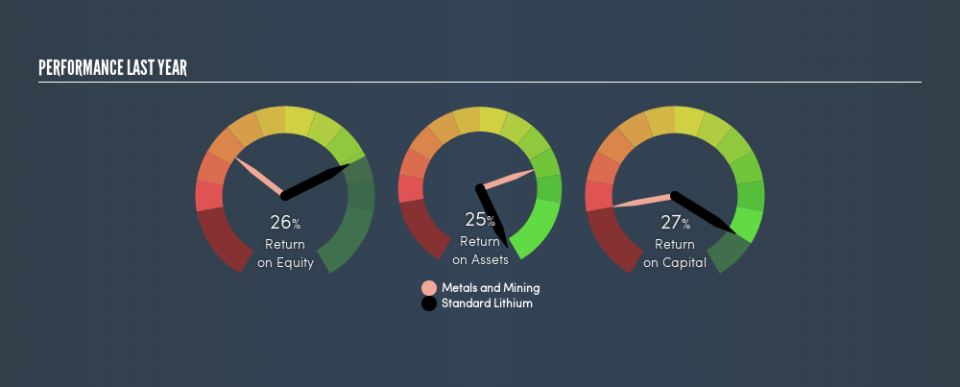Why You Should Like Standard Lithium Ltd.’s (CVE:SLL) ROCE

Want to participate in a short research study? Help shape the future of investing tools and you could win a $250 gift card!
Today we'll look at Standard Lithium Ltd. (CVE:SLL) and reflect on its potential as an investment. To be precise, we'll consider its Return On Capital Employed (ROCE), as that will inform our view of the quality of the business.
First up, we'll look at what ROCE is and how we calculate it. Second, we'll look at its ROCE compared to similar companies. Then we'll determine how its current liabilities are affecting its ROCE.
Return On Capital Employed (ROCE): What is it?
ROCE measures the 'return' (pre-tax profit) a company generates from capital employed in its business. All else being equal, a better business will have a higher ROCE. Overall, it is a valuable metric that has its flaws. Renowned investment researcher Michael Mauboussin has suggested that a high ROCE can indicate that 'one dollar invested in the company generates value of more than one dollar'.
How Do You Calculate Return On Capital Employed?
Analysts use this formula to calculate return on capital employed:
Return on Capital Employed = Earnings Before Interest and Tax (EBIT) ÷ (Total Assets - Current Liabilities)
Or for Standard Lithium:
0.27 = CA$10m ÷ (CA$40m - CA$1.7m) (Based on the trailing twelve months to March 2019.)
Therefore, Standard Lithium has an ROCE of 27%.
See our latest analysis for Standard Lithium
Is Standard Lithium's ROCE Good?
One way to assess ROCE is to compare similar companies. Using our data, we find that Standard Lithium's ROCE is meaningfully better than the 3.0% average in the Metals and Mining industry. I think that's good to see, since it implies the company is better than other companies at making the most of its capital. Putting aside its position relative to its industry for now, in absolute terms, Standard Lithium's ROCE is currently very good.
You can see in the image below how Standard Lithium's ROCE compares to its industry. Click to see more on past growth.
When considering this metric, keep in mind that it is backwards looking, and not necessarily predictive. ROCE can be deceptive for cyclical businesses, as returns can look incredible in boom times, and terribly low in downturns. This is because ROCE only looks at one year, instead of considering returns across a whole cycle. Remember that most companies like Standard Lithium are cyclical businesses. Since the future is so important for investors, you should check out our free report on analyst forecasts for Standard Lithium.
Standard Lithium's Current Liabilities And Their Impact On Its ROCE
Current liabilities include invoices, such as supplier payments, short-term debt, or a tax bill, that need to be paid within 12 months. Due to the way ROCE is calculated, a high level of current liabilities makes a company look as though it has less capital employed, and thus can (sometimes unfairly) boost the ROCE. To check the impact of this, we calculate if a company has high current liabilities relative to its total assets.
Standard Lithium has total liabilities of CA$1.7m and total assets of CA$40m. Therefore its current liabilities are equivalent to approximately 4.2% of its total assets. Standard Lithium has low current liabilities, which have a negligible impact on its relatively good ROCE.
What We Can Learn From Standard Lithium's ROCE
This is an attractive combination and suggests the company could have potential. There might be better investments than Standard Lithium out there, but you will have to work hard to find them . These promising businesses with rapidly growing earnings might be right up your alley.
If you like to buy stocks alongside management, then you might just love this free list of companies. (Hint: insiders have been buying them).
We aim to bring you long-term focused research analysis driven by fundamental data. Note that our analysis may not factor in the latest price-sensitive company announcements or qualitative material.
If you spot an error that warrants correction, please contact the editor at editorial-team@simplywallst.com. This article by Simply Wall St is general in nature. It does not constitute a recommendation to buy or sell any stock, and does not take account of your objectives, or your financial situation. Simply Wall St has no position in the stocks mentioned. Thank you for reading.

 Yahoo Finance
Yahoo Finance 
